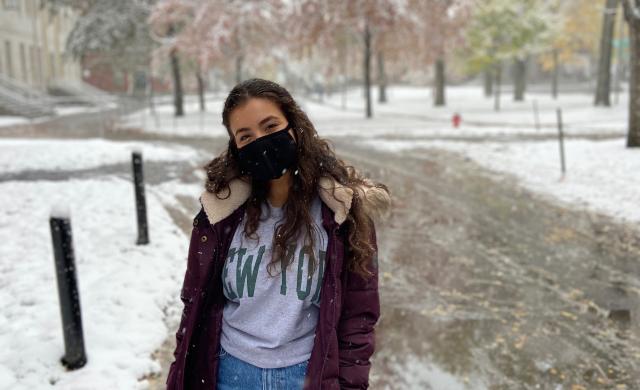As a coordinator with the UMRP (Undergraduate Minority Recruitment Program), one of the most common questions is how harsh the Boston winter can be, and how to prepare.
Growing up in northern Minnesota where we are commonly considered to have some of the most brutal winters in the United States, so you can trust me when I say that I know how to prepare for the oncoming cold. Boston winters are snowy, rainy, and icy. Although not as cold and with far less consistent snow cover than I am used to, Boston weather is extremely irregular. I have found that it rains more than it snows, so maybe think about an umbrella or some rain gear.
Living in a suite with two Floridians and a Texan, the onset of wintry weather as we near winter break has meant my closet became more communal and prompted many lessons about layering for the increasingly chilly weather. I often find myself bringing extra flannels or coats out even when I wouldn’t wear them just because I knew that walking place to place someone would end up chilled.
Here are some of the common struggles and the essential items and advice that I would have for someone who has never experienced a snowy winter in Cambridge.
My first piece of First advice is a hard and fast rule that I grew up with: do not go outside in the winter with wet hair. Not only will your hair dry slowly and in an unflattering manner, but running to class on a sub-freezing day fresh out of the shower is an easy way to catch a cold.
Layering and being able to adjust your outfit to the temperature is important. Flannels are a staple in every Minnesotan’s closet, and in the late fall months I often layer a flannel inside of my light jacket which allows me to be flexible, especially when just getting to class and perhaps still too cold to just sit in my shirt and not wanting to stay in a stuffy coat. Flannels, sweaters, fleeces, and sweatshirts are all very good to have.
This brings me to sweaters. Sometimes it can be easy to think a big chunky sweater is all you need on a forty degree day, and normally I do it, but sometimes walking outside is a brutal reality check and the wind blows straight through it. Not every sweater is made equally, and same with flannels. Go for a thicker flannel instead of a thin fashion flannel if you want warmth, and for sweaters a wool or some acrylic blends will do much more for you than a loosely knit sweater could, so just prepare to layer on top of a cute sweater if it isn’t necessarily the warmest.
It is easy to layer on the top, but what about when the temperature drops and jeans just aren’t holding in any heat? My best advice is to get tights, leggings, or long underwear/cuddl duds (soft and warm long sleeved tops and leggings made to layer over normally used for skiing) and wear these under your sweatpants, skirts, or jeans.
Wool socks are a staple. Nothing is worse than having a long walk back to your dorm and your toes are aching and losing feeling from the cold, even if you layer them. Having at least one good pair of wool socks will do you very well, and are downright necessary if you plan on trying out winter activities like ice skating, skiing, snowshoeing, or anything where you are going to be out for a while in the elements.
Hats, gloves, and scarves are more than just cute winter and fall accessories. Trust me, walking to class or to go to a sports game on a chilly day makes having gloves or a scarf for your face and neck feel like a luxury. They work! It only takes one time thawing out your ears and fingers to make anyone a believer. My personal favorite is having a small pair of gloves, and when it gets cold, I layer them inside of some of the mittens that my dad makes for the farmer’s market back home.
You need to get waterproof winter boots- and make sure to check the temperature rating! This may be more important back in Minnesota where it can get sub negative thirty, but in Boston where the coldest you’ll likely deal with is the single digits make sure the boots say they are made for that! Nothing is worse than thinly insulated boots. Additionally, make sure that they are made for snow and waterproof- snow melts and will get your boots wet and unless you enjoy thawing out your toes, getting good boots are more than worth it. And they last years.
Lastly, and I am sure you have heard this song sung a hundred times, but invest in a good winter coat. Make sure it is rated for the single digits, and that it is once more waterproof and something you won’t mind wearing for years to come. If you aren’t planning on doing a lot of winter sports after college, try to find one that you could use everyday but could also be versatile and used perhaps if you ever try out skiing, so you only need one coat.
Northern thrift stores are great resources to find nice sweaters and flannels, and often times churches or other groups will have coat drives. I know in the past there has been Harvard’s Winter Coat Fund for first-year students who are on full aid which gives you $200 to help afford a coat, so look out for that! More on the coat fund can be found here: https://college.harvard.edu/life-harvard/student-stories/additional-res….
To finish off, always feel free to ask your northern friends for their input! We are all open to helping out and we understand that this is a big adjustment and your friends are great resources. Stay warm out there!












